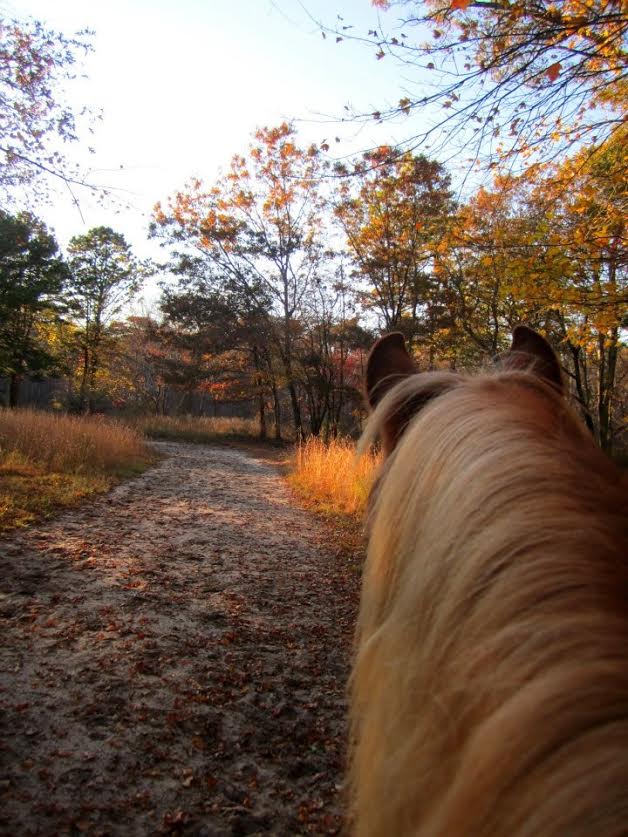
The Trail Rider’s Guide to Fall Riding Safety
These simple tips could go a long way in the event of an accident.
Sweater-weather temps, fiery-hued foliage, horses with a little pep in their step… autumn is high season for hitting the trail. Are you prepared? Kristen Pierce has some advice.
From Kristen:
Many of us aren’t ready to let go of summer. But autumn is upon us once again and it’s important for us as riders to be refreshed about fall riding safety.
It is common for horses to start to really “feel good” during the early fall months. The air is cooler, it’s crisp, the bugs are gone (THANK GOD!), and most importantly, our horses love this time of year — so much that you will get to see all of those impressive gymnastic/ballet moves they have been hiding all summer from you. But let’s not forget about how we can fulfill our duty as riders, our no. 1 responsibility being to keep our horse and ourselves safe while enjoying a nice fall ride… and keeping the flying pirouettes at bay!
A few tips:
Protect your head. The most important part of your body resides in your head. Yes, you guessed it, your brain! Wear your helmet every single time you ride. Protect what keeps you functioning and able.
Ride with a buddy. The buddy system will never fail. Look out for each other, and if you’re lucky enough to have a calm horse that isn’t bothered by much — still have a friend with you. It will be nice to enjoy their company.
Check your tack. Make sure all of your tack is in good working order before you hit the trails.
Warm up your horse. Give your horse some time to stretch, bend and warm up his muscles before you start doing any kind of intensive trail riding. The cooler it gets outside, the cooler your horse’s muscles get and the longer it takes to properly warm them up. Start out walking for at least 10 minutes while asking for some bending, then move to a working trot and proceed from there. You and your horse will have a much smoother ride and it gives you some time to tune your horse’s attention to you.
Protect your horse’s feet. Putting bell boots on your horse’s feet is never a bad idea. All it takes is one overreach with a hind leg to clip the front and, depending upon how bad the nick is, it could take months to heal. If you think your horse might get silly out there, consider a pair of protective boots as well.
Be seen. Wear bright colors so you stand out to others — especially if you are in an area that is not a state park or preserve.
Keep your eye on the horizon. With fall comes shorter days. And, let’s face it, we want to squeeze every last bit of daylight out of the day. Be aware of the time, your location and how long it will take you to get home from where you are while making sure that you will be back at the barn before the sun has set.
Carry your phone. Don’t become unreachable when you are out trail riding. There are many online tack stores that carry convenient cell phone holders that Velcro wrap around your leg or arm, attach to your belt or clip onto your boot. Keep your phone on you, physically. Don’t use the cell phone holders that are built into or attach to saddles. If you and your horse become separated and your phone was tucked away in the nice cell phone holder on your saddle… well, that isn’t going to help you very much anymore.
Which leads me to my final tip of safety:
ID your horse. Any sporting goods store carries clear waterproof pouches (you can find them in the camping or hunting aisle) into which you can insert an index card. Fill it out with some some basic information about your horse and attach it to your saddle pad or saddle.
Things to include:
• Your horse’s home location so your horse can be returned.
• Your cell phone number so you can be reached.
• An emergency contact number — if you can’t be reached, hopefully this person can!
• A phone number for someone who has a trailer, for your horse’s transportation home if found far from home.
Keeping these tips on hand will help you make the most out of your fall
trail rides. You’ll be able to ride safely and confidently knowing that you and your equine partner are in sync with each other and that you have covered the most important areas of safety when it comes to trail riding during this season change.
Enjoy the weather, and Ride Smart!
Kristen is a versatile equestrian who grew up as a western pleasure rider. Since then, she has expanded her interest in almost everything from (but not limited to) barrel racing, hunter/jumper, eventing and her newest feat, extreme trail. Plainly speaking, her life revolves around her two horses. Kristen’s youngest horse, Ace, is a 4-year-old Quarter Horse/Haflinger cross who she trained herself since he was a yearling. Kristen is also a huge rescue advocate for all animals. You can bet that both of her horses are rescues as well!









Leave a Comment